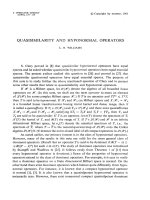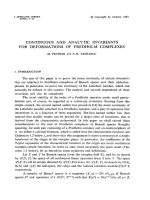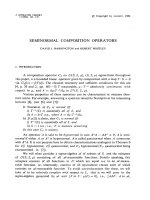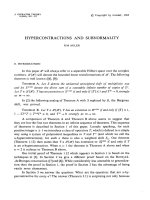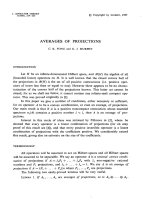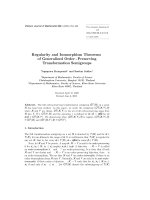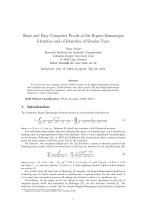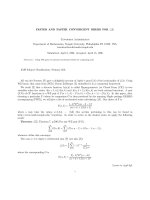Báo cáo toán học: "Eigenvectors and Reconstruction" pps
Bạn đang xem bản rút gọn của tài liệu. Xem và tải ngay bản đầy đủ của tài liệu tại đây (105.71 KB, 8 trang )
Eigenvectors and Reconstruction
Hongyu He
∗
Department of Mathematics
Louisiana State University, Baton Rouge, USA
Submitted: Jul 6, 2006; Accepted: Jun 14, 2007; Published: Jul 5, 2007
Mathematics Subject Classification: 05C88
Abstract
In this paper, we study the simple eigenvectors of two hypomorphic matrices
using linear algebra. We also give new proofs of results of Godsil and McKay.
1 Introduction
We start by fixing some notations ( [HE1]). Let A be a n × n real symmetric matrix. Let
A
i
be the matrix obtaining by deleting the i-th row and i-th column of A. We say that
two symmetric matrices A and B are hypomorphic if, for each i, B
i
can be obtained by
simultaneously permuting the rows and columns of A
i
. Let Σ be the set of permutations.
We write B = Σ(A).
If M is a symmetric real matrix, then the eigenvalues of M are real. We write
eigen(M) = (λ
1
(M) ≥ λ
2
(M) ≥ . . . ≥ λ
n
(M)).
If α is an eigenvalue of M, we denote the corresponding eigenspace by eigen
α
(M). Let 1
be the n-dimensional vector (1, 1, . . . , 1). Put J = 1
t
1. In [HE1], we proved the following
theorem.
Theorem 1 ( [HE1]) Let B and A be two real n × n symmetric matrices. Let Σ be a
hypomorphism such that B = Σ(A). Let t be a real number. Then there exists an open
interval T such that for t ∈ T we have
1. λ
n
(A + tJ) = λ
n
(B + tJ);
2. eigen
λ
n
(A + tJ) and eigen
λ
n
(B + tJ) are both one dimensional;
∗
I would like to thank the referee for his valuable comments.
the electronic journal of combinatorics 14 (2007), #N14 1
3. eigen
λ
n
(A + tJ) = eigen
λ
n
(B + tJ).
As proved in [HE1], our result implies Tutte’s theorem which says that eigen(A + tJ) =
eigen(B + tJ). So det(A + tJ − λI) = det(B + tJ − λI).
In this paper, we shall study the eigenvectors of A and B. Most of the results in this
paper are not new. Our approach is new. We apply Theorem 1 to derive several well-
known results. We first prove that the squares of the entries of simple unit eigenvectors
of A can be reconstructed as functions of eigen(A) and eigen(A
i
). This yields a proof of
a Theorem of Godsil-McKay. We then study how the eigenvectors of A change after a
perturbation of rank 1 symmetric matrices. Combined with Theorem 1, we prove another
result of Godsil-McKay which states that the simple eigenvectors that are perpendicular
to 1 are reconstructible. We further show that the orthogonal projection of 1 onto higher
dimensional eigenspaces is reconstructible.
Our investigation indicates that the following conjecture could be true.
Conjecture 1 Let A be a real n × n symmetric matrix. Then there exists a subgroup
G(A) ⊆ O(n) such that a real symmetric matrix B satisfies the properties that eigen(B) =
eigen(A) and eigen(B
i
) = eigen(A
i
) for each i if and only if B = UAU
t
for some
U ∈ G(A).
This conjecture is clearly true if rank(A) = 1. For rank(A) = 1, the group G(A) can be
chosen as Z
n
2
, all in the form of diagonal matrices. In some other cases, G(A) can be a
subgroup of the permutation group S
n
.
2 Reconstruction of Square Functions
Theorem 2 Let A be a n × n real symmetric matrix. Let (λ
1
≥ λ
2
≥ · · · ≥ λ
n
) be the
eigenvalues of A. Suppose λ
i
is a simple eigenvalue of A. Let p
i
= (p
1,i
, p
2,i
, . . . , p
n,i
)
t
be a unit vector in eigen
λ
i
(A). Then for every m, p
2
m,i
can be expressed as a function of
eigen(A) and eigen(A
m
).
Proof: Let λ
i
be a simple eigenvalue of A. Let p
i
= (p
1,i
, p
2,i
, . . . , p
n,i
)
t
be a unit vector
in eigen
λ
i
(A). There exists an orthogonal matrix P such that P = (p
1
, p
2
, · · · , p
n
) and
A = P DP
t
where
D =
λ
1
0 · · · 0
0 λ
2
· · · 0
.
.
.
.
.
.
.
.
.
.
.
.
0 0 · · · λ
n
.
Then
A − λ
i
I = PDP
t
− λ
i
I = P(D − λ
i
I)P
t
=
j=i
(λ
j
− λ
i
)p
j
p
t
j
.
the electronic journal of combinatorics 14 (2007), #N14 2
which equals
p
1,1
· · · p
1,i
· · · p
1,n
p
2,1
· · · p
2,i
· · · p
2,n
.
.
.
.
.
.
.
.
.
.
.
.
.
.
.
p
n,1
· · · p
n,i
· · · p
n,n
λ
1
− λ
i
· · · 0 · · · 0
.
.
.
.
.
.
.
.
.
.
.
.
.
.
.
0 · · ·
λ
i
− λ
i
· · · 0
.
.
.
.
.
.
.
.
.
.
.
.
.
.
.
0 · · · 0 · · · λ
n
− λ
i
p
1,1
p
2,1
· · · p
n,1
.
.
.
.
.
.
.
.
.
.
.
.
p
1,i
p
2,i
· · · p
n,i
.
.
.
.
.
.
.
.
.
.
.
.
p
1,n
p
2,n
· · · p
n,n
.
Deleting the m-th row and m-th column, we obtain
p
1,1
· · · p
1,i
· · · p
1,n
.
.
.
.
.
.
.
.
.
.
.
.
.
.
.
p
m,1
· · · p
m,i
· · · p
m,n
.
.
.
.
.
.
.
.
.
.
.
.
.
.
.
p
n,1
· · · p
n,i
· · · p
n,n
λ
1
− λ
i
· · · 0 · · · 0
.
.
.
.
.
.
.
.
.
.
.
.
.
.
.
0 · · ·
λ
i
− λ
i
· · · 0
.
.
.
.
.
.
.
.
.
.
.
.
.
.
.
0 · · · 0 · · · λ
n
− λ
i
p
1,1
· · · p
m,1
· · · p
n,1
.
.
.
.
.
.
.
.
.
.
.
.
.
.
.
p
1,i
· · · p
m,i
· · · p
n,i
.
.
.
.
.
.
.
.
.
.
.
.
.
.
.
p
1,n
· · · p
m,n
· · · p
n,n
.
This is A
m
− λ
i
I
n−1
. Notice that P is orthogonal. Let P
m,i
be the matrix obtained by
deleting the m-th row and i-th column. Then det P
2
m,i
= p
2
m,i
where p
m,i
is the (m, i)-th
entry of P . Taking the determinant, we have
det(A
m
− λ
i
I
n−1
) = p
2
m,i
j=i
(λ
j
− λ
i
).
It follows that
p
2
m,i
=
n−1
j=1
(λ
j
(A
m
) − λ
i
)
j=i
(λ
j
− λ
i
)
.
Q.E.D.
Corollary 1 Let A and B be two n×n real symmetric matrices. Suppose that eigen(A) =
eigen(B) and eigen(A
i
) = eigen(B
i
). Let λ
i
be a simple eigenvalue of A and B. Let
the electronic journal of combinatorics 14 (2007), #N14 3
p
i
= (p
1,i
, p
2,i
, . . . , p
n,i
)
t
be a unit vector in eigen
λ
i
(A) and q
i
= (q
1,i
, q
2,i
, . . . , q
n,i
)
t
be a
unit vector in eigen
λ
i
(B). Then
p
2
j,i
= q
2
j,i
∀j ∈ [1, n].
Corollary 2 (Godsil-McKay, see Theorem 3.2, [GM]) Let A and B be two n × n
real symmetric matrices. Suppose that A and B are hypomorphic. Let λ
i
be a simple
eigenvalue of A and B. Let p
i
= (p
1,i
, p
2,i
, . . . , p
n,i
)
t
be a unit vector in eigen
λ
i
(A) and
q
i
= (q
1,i
, q
2,i
, . . . , q
n,i
)
t
be a unit vector in eigen
λ
i
(B). Then
p
2
j,i
= q
2
j,i
∀j ∈ [1, n].
3 Eigenvalues and Eigenvectors under the perturba-
tion of a rank one symmetric matrix
Let A be a n × n real symmetric matrix. Let x be a n-dimensional row column vector.
Let M = xx
t
. Now consider A + tM. We have
A + tM = PDP
t
+ tM = P (D + tP
t
MP )P
t
= P (D + tP
t
xx
t
P )P
t
.
Let P
t
x = q. So q
i
= (p
i
, x) for each i ∈ [1, n]. Then
A + tM = P (D + tqq
t
)P
t
.
Put D(t) = D + tqq
t
.
Lemma 1 det(D + tqq
t
− λI) = det(A − λI)(1 +
i
tq
2
i
λ
i
−λ
).
Proof: det(D − λI + tqq
t
) can be written as a sum of products of λ
i
− λ and q
i
q
j
. For
each S a subset of [1, n], combine the terms containing only
i∈S
(λ
i
− λ). Since the rank
of qq
t
is one, only for |S| = n, n − 1, the coefficients may be nonzero. We obtain
det(D + tqq
t
− λI) =
n
i=1
(λ
i
− λ) +
n
i=1
tq
2
i
j=i
(λ
i
− λ).
The Lemma follows.
Put P
t
(λ) = 1 +
i
tq
2
i
λ
i
−λ
.
Lemma 2 Fix t < 0. Suppose that λ
1
, λ
2
, . . . , λ
n
are distinct and q
i
= 0 for every i.
Then P
t
(λ) has exactly n roots (µ
1
, µ
2
, · · · , µ
n
) satisfying an interlacing relation:
λ
1
> µ
1
> λ
2
> µ
2
> · · · > µ
n−1
> λ
n
> µ
n
.
the electronic journal of combinatorics 14 (2007), #N14 4
Proof: Clearly,
dP
t
(λ)
dλ
=
i
tq
2
i
(λ
i
−λ)
2
< 0. So P
t
(λ) is always decreasing. On the interval
(−∞, λ
n
), lim
λ→−∞
P
t
(λ) = 1 and lim
λ→λ
−
n
P
t
(λ) = −∞. So P
t
(λ) has a unique root
µ
n
∈ (−∞, λ
n
). Similar statement holds for each (λ
i−1
, λ
i
). On (λ
1
, ∞), lim
λ→∞
P
t
(λ) = 1
and lim
λ→λ
+
1
P
t
(λ) = ∞. So P
t
(λ) does not have any roots in (λ
1
, ∞). Q.E.D.
Theorem 3 Fix t < 0 and x ∈ R
n
. Let M = xx
t
. Let l be the number of dis-
tinct eigenvalues satisfying (x, eigen
λ
(A)) = 0. Choose an orthonormal basis of each
eigenspace of A so that one of the eigenvectors is a multiple of the orthogonal projection
of x onto the eigenspace if this projection is nonzero. Denote this basis by {p
i
} and let
P = (p
1
, p
2
, . . . , p
n
). Let
S = {i
1
> i
2
> · · · > i
l
}
such that (x, p
i
) = 0 for every i ∈ S and (x, p
i
) = 0 for every i /∈ S. Then there exists
(µ
1
, . . . , µ
l
) such that
λ
i
1
> µ
1
> λ
i
2
> µ
2
> · · · > λ
i
l
> µ
l
and
eigen(A + tM) = {λ
i
(A) | i /∈ S} ∪ {µ
1
, µ
2
. . . , µ
l
}.
Furthermore, eigen
µ
j
(A + tM) contains
i∈S
p
i
q
i
λ
i
− µ
j
.
Here the index set {i
1
, i
2
, · · · , i
l
} may not be unique. I shall also point out a similar
statement holds for t > 0 with
µ
1
> λ
i
1
> µ
2
> λ
i
2
> · · · > µ
l
> λ
i
l
.
Proof: Recall that q
i
= (p
i
, x). Since (x, eigen
λ
i
j
(A)) = 0, q
i
j
= 0. For i /∈ S, q
i
= 0.
Notice
P
t
(λ) = 1 +
l
j=1
tq
2
i
j
λ
i
j
− λ
.
Applying Lemma 2 to S, we obtain the roots of P
t
(λ), {µ
1
, µ
2
, . . . , µ
l
}, satisfying
λ
i
1
> µ
1
> λ
i
2
> µ
2
> · · · > λ
i
l
> µ
l
.
It follows that the roots of det(A + tM − λI) = P
t
(λ)
n
i=1
(λ
i
− λ) can be obtained from
eigen(A) be changing {λ
i
1
> λ
i
2
> · · · > λ
i
l
} to {µ
1
, µ
2
. . . , µ
l
}. Therefore,
eigen(A + tM) = {λ
i
(A) | i /∈ S} ∪ {µ
1
, µ
2
. . . , µ
l
}.
the electronic journal of combinatorics 14 (2007), #N14 5
Fix a µ
j
. Let {e
i
} be the standard basis for R
n
. Notice that
(A + tM)
i∈S
q
i
λ
i
− µ
j
p
i
=P (D + tqq
t
)P
t
i∈S
q
i
λ
i
− µ
j
p
i
=P (D + tqq
t
)
i∈S
q
i
λ
i
− µ
j
e
i
=P
i∈S
λ
i
q
i
λ
i
− µ
j
e
i
+ t
q
1
.
.
.
q
n
i∈S
q
2
i
λ
i
− µ
j
=P
i∈S
λ
i
q
i
λ
i
− µ
j
e
i
−
i∈S
q
i
e
i
=P
i∈S
µ
j
q
i
λ
i
− µ
j
e
i
=µ
j
i∈S
q
i
λ
i
− µ
j
p
i
(1)
Notice that here we use the fact that P
t
(µ
j
) =
i∈S
tq
2
i
λ
i
−µ
j
+ 1 = 0. We have obtained
that (A + tM)
λ
i
∈S
q
i
λ
i
−µ
j
p
i
= µ
j
i∈S
q
i
λ
i
−µ
j
p
i
. Therefore,
i∈S
q
i
λ
i
− µ
j
p
i
∈ eigen
µ
j
(A + tM).
Q.E.D.
4 Reconstruction of Simple Eigenvectors not perpen-
dicular to 1
Now let M = J = 11
t
. Theorem 3 applies to A + tJ and B + tJ.
Theorem 4 (Godsil-McKay, [GM]) Let B and A be two real n × n symmetric ma-
trices. Let Σ be a hypomorphism such that B = Σ(A). Let S ⊆ [1, n], A = P DP
t
and
B = UDU
t
be as in Theorem 3. For i ∈ S, we have p
i
= u
i
or p
i
= −u
i
. In particular,
if λ
i
is a simple eigenvalue of A and (eigen
λ
i
(A), 1) = 0, then eigen
λ
i
(A) = eigen
λ
i
(B).
Proof: • By Tutte’s theorem, eigen(A) = eigen(B). Let A = P DP
t
and B = UDU
t
.
Since det(A + tJ − λI) = det(B + tJ − λI), by Lemma 1,
det(A − λI)(1 +
i
t(1, p
i
)
2
λ
i
− λ
) = det(B − λI)(1 +
i
t(1, u
i
)
2
λ
i
− λ
).
the electronic journal of combinatorics 14 (2007), #N14 6
It follows that for every λ
i
,
λ
j
=λ
i
(1, p
j
)
2
=
λ
j
=λ
i
(1, u
j
)
2
. Consequently, the l for A is
the same as the l for B. Let S be as in Theorem 3 for both A and B. Without loss of
generality, suppose that A = P DP
t
and B = UDU
t
as in Theorem 3. In particular, for
every i ∈ [1, n], we have
(p
i
, 1)
2
= (u
i
, 1)
2
. (2)
• Let T be as in the proof of Theorem 1 in [HE1] for A and B. Without loss of generality,
suppose T = (t
1
, t
2
) ⊆ R
−
. Let t ∈ T and let µ
l
(t) be the µ
l
in Theorem 3 for A and
B. Notice that the lowest eigenvectors of A + tJ and B + tJ are in R
+
n
(see Lemma 1,
Theorem 7 and Proof of Theorem 2 in [HE1]). So they are not perpendicular to 1. By
Theorem 3, µ
l
(t) = λ
n
(A + tJ) = λ
n
(B + tJ). By Theorem 1,
eigen
µ
1
(t)
(A + tJ) = eigen
µ
l
(t)
(B + tJ)
∼
=
R.
So
i∈S
p
i
(p
i
,1)
λ
i
−µ
l
(t)
is parallel to
i∈S
u
i
(u
i
,1)
λ
i
−µ
l
(t)
. Since {p
i
} and {u
i
} are orthonormal, by
Equation 2,
i∈S
p
i
(p
i
, 1)
λ
i
− µ
l
(t)
2
=
i∈S
u
i
(u
i
, 1)
λ
i
− µ
l
(t)
2
.
It follows that for every t ∈ T,
i∈S
p
i
(p
i
, 1)
λ
i
− µ
l
(t)
= ±
i∈S
u
i
(u
i
, 1)
λ
i
− µ
l
(t)
.
• Recall that −
1
t
=
i
q
2
i
λ
i
−µ
l
(t)
. Notice that the function ρ →
i
q
2
i
λ
i
−ρ
is a continuous
and one-to-one mapping from (−∞, λ
n
) onto (0, ∞). There exists a nonempty interval
T
0
⊆ (−∞, λ
n
) such that if ρ ∈ T
0
, then
i
q
2
i
λ
i
−ρ
∈ (−
1
t
1
, −
1
t
2
). So every ρ ∈ T
0
is a µ
l
(t)
for some t ∈ (t
1
, t
2
). It follow that for every ρ ∈ T
0
,
i∈S
p
i
(p
i
, 1)
λ
i
− ρ
= ±
i∈S
u
i
(u
i
, 1)
λ
i
− ρ
.
Notice that both vectors are nonzero and depend continuously on ρ. Either,
i∈S
p
i
(p
i
, 1)
λ
i
− ρ
=
i∈S
u
i
(u
i
, 1)
λ
i
− ρ
∀ (ρ ∈ T
0
);
or,
i∈S
p
i
(p
i
, 1)
λ
i
− ρ
= −
i∈S
u
i
(u
i
, 1)
λ
i
− ρ
∀ (ρ ∈ T
0
);
•. Notice that the functions {ρ →
1
λ
i
j
−ρ
}|
i
j
∈S
are linearly independent. For every i ∈ S,
we have
p
i
(p
i
, 1) = ±u
i
(u
i
, 1).
Because p
i
and u
i
are both unit vectors, p
i
= ±u
i
. In particular, for every simple λ
i
with
(p
i
, 1) = 0 we have eigen
λ
i
(A) = eigen
λ
i
(B). Q.E.D.
the electronic journal of combinatorics 14 (2007), #N14 7
Corollary 3 Let B and A be two real n × n symmetric matrices. Suppose that B = Σ(A)
for a hypomorphism Σ. Let λ
i
be an eigenvalue of A such that (eigen
λ
i
(A), 1) = 0. Then
the orthogonal projection of 1 onto eigen
λ
i
(A) equals the orthogonal projection of 1 onto
eigen
λ
i
(B).
Proof: Notice that the projections are p
i
(p
i
, 1) and u
i
(u
i
, 1). Whether p
i
= u
i
or p
i
=
−u
i
, we always have
p
i
(p
i
, 1) = u
i
(u
i
, 1).
Q.E.D.
Conjecture 2 Let A and B be two hypomorphic matrices. Let λ
i
be a simple eigenvalue
of A. Then there exists a permutation matrix τ such that τeigen
λ
i
(A) = eigen
λ
i
(B).
This conjecture is apparently true if eigen
λ
i
(A) is not perpendicular to 1.
References
[Tutte] W. T. Tutte, “All the King’s Horses (A Guide to Reconstruction)”, Graph Theory
and Related Topics, Academic Press, 1979, (15-33).
[GM] C. D. Godsil and B. D. McKay, “Spectral Conditions for the Reconstructiblity of
a graph”, J. Combin. Theory Ser. B 30. 1981, No. 3, (285-289).
[HE1] H. He, “Reconstruction and Higher Dimensional Geometry”, Journal of Combina-
torial Theory, Series B 97, No 3 (421-429).
[Ko] W. Kocay, “Some New Methods in Reconstruction Theory”, Combinatorial mathe-
matics, IX (Brisbane, 1981), LNM 952, (89-114).
the electronic journal of combinatorics 14 (2007), #N14 8
